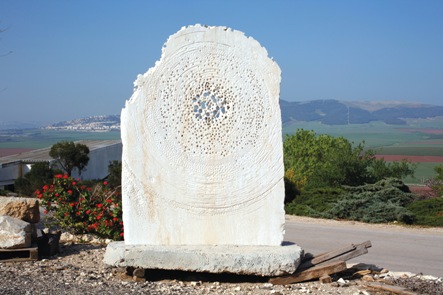By Angela Levine
Cosmic Seeds, a sculpture exhibition featuring new works by South-African born artist Bernie Fink proves to be something of a revelation.
Although now exhibiting at the Open Museum in the Industrial Park at Omer in the south of the country, the sculptor actually lives and works in the north, on Kibbutz Yisre’el in the Jezre’el valley, where he settled more than 40 years ago.
Fink’s name has long been associated with a group of ‘Galilean’ sculptors who came to prominence in the 1980s. Most of them, women as well as men, were kibbutz members. Utilizing materials directly from their environment, such as basalt stone and olive wood, and drawing inspiration from local archeological finds as well as ancient myths, they produced objects akin to shrines, altars or primitive agricultural implements.
Hints that Fink had moved away from this group in an independent direction have surfaced only intermittently in the past decade; the reason being that his work was rarely seen in the main city centers; and scant publicity was accorded his occasional participation in stone sculpture symposia in Israel or abroad.
But here, under desert skies, we find Fink has become his own man. Setting aside his previous attachment to the local landscape and terrain, he now appears to be reaching, as it were, for the stars, offering up an ambitious 20-piece collection of sculptures, mostly in stone, inspired by his fantasies regarding the cosmos, its celestial bodies and galaxies.
In conversation, Fink admits that his representations of the cosmos are not based on scientific facts, but evolved only from his imagination. “Today” he says: “telescopic cameras take pictures of a world where explosions occurred millions of years ago. What we see no longer exists.” These vanished entities are represented in Fink’s works by a honeycomb of holes and spaces of differing diameters, drilled through his stone to various depths.
Aside from the innovative nature of this theme, a new delicacy of touch is observed in his work. Employing a mixture of carving, drilling and dense texturing of surfaces, he has produced, where appropriate, lace-like effects resembling embroidery.
Imagination, and plenty of it, is mandatory if one seeks to get the maximum pleasure from this exhibition whose starting point is Fink’s visualization of cosmic seeds, described by scientists as the ‘wrinkles in time’ from which galaxies and planets have developed. He sculpts them from grey basalt stone as ovoid objects cracked open to reveal a pitted grey core; or else, from white dolomite stone to produce small gleaming artifacts resembling seashells.
Walking past some rather humdrum representations in concrete and metal of a meteor and UFOs, one’s attention is firmly held, by various monumental stone pieces, including Space Panorama – a large square sheet of granite suspended from an iron frame. The surface of this area, freely carved into depressions and ridges, has a deep vertical line scoring across its length, signifying, perhaps, the flight path of a cosmic body.

Next in view are several beautiful sculptures given the title Galaxy. Carved from creamy yellow Mitzpeh Ramon stone and set upright in the ground, their surfaces are ornamented with delicate spiral patterns. In one example, tiny basalt spheres are embedded into the stone, casting a shadow that alters with the movement of the sun so that, in effect, they function as cosmic landmarks. Through the fretwork of holes ornamenting the surfaces of this standout sculptural group, one obtains glimpses of the blue sky and desert landscape which form such an effective backdrop to this exhibition.
There is no closing date at present.
For opening times phone 972-8-6492692
Top Image: Bernie Fink: Small cosmic seed, 2007, dolomite on basalt stone
Angela Levine is Midnight East’s Art Critic






I saw Bernie Fink’s exhibit at The Open Museum – Omer yesterday and am pleased to be able read about him.
Comments are closed.